Home / Seat of the Kingdom
Seat of the Kingdom
The city of Shahjahanabad, now Old Delhi, was founded by the fifth of the Great Mughals, Shah Jahan, in 1648. The Emperor was forty-seven years old when he decided to move his court from Agra to Delhi. He had just lost his favorite wife; his children were now grown. The building of a new imperial city, adjacent to the great Sultanate capitals of medieval Delhi, was the Emperor’s last great bid for immortality. It was a vastly expensive project and the resources of the entire Empire were poured into the construction of the city. The result was extraordinary. The Persian inscription painted in the Hall of Private Audience proudly proclaimed: “If there is paradise on earth, it is here, it is here, it is here!” Within a few years, Delhi grew to be the largest city in South Asia.
The cultural flourishing and glamour of the new city did not, however, survive the transition to power of the Emperor’s most puritanical and least cultured son, Aurangzeb, who showed little interest in painting and spent most of his life campaigning in the south. As the French jeweler Tavernier noted on arrival in Delhi in 1665, “The city appears to be a desert when the King is absent. If there have been 400,000 men in it when the King was there, there hardly remains the sixth part in his absence.”
The death of Aurangzeb in 1707 rapidly fragmented the Empire and Delhi descended into chaos. Three Emperors were murdered; one of them, Farrukhsiyyar, was imprisoned and starved, and later blinded and strangled. These conditions were far from ideal for cultural patronage, yet, as is evident from the examples on view in this gallery, the painting atelier at Delhi, the source of the great masterpieces of Shah Jahan’s reign, continued to produce works during and after the rule of Aurangzeb. Moreover, the courts of Bahadur Shah I, Jahandar Shah, and Farrukhsiyar all fostered painters who developed their own distinguished palette utilizing a decorative and highly refined approach to figural representation.
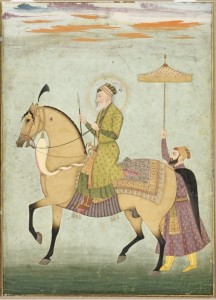
The Emperor Aurangzeb on Horseback ca. 1690–1710 Color on paper H.12 x W.8 3/4 in. (30.5 x 22.3 cm) The Cleveland Museum of Art, Andrew R. and Martha Holden Jennings Fund, 1971.81
In 1657 Aurangzeb, pictured here on horseback, imprisoned his father and arranged for the deaths of his own brothers, and then chose to be crowned as Emperor Alamgir in his father’s Shalimar Gardens in Delhi. This painting, while maintaining the mainstream tradition of Mughal equestrian portraits, seems oddly disjointed, as it combines the stiff formality and remoteness of the figures with the ornamental and somewhat lush details of their dress and the emperor’s mount. In this painting executed toward the end of his life, or shortly after his death, an elderly Aurangzeb is depicted as mellow but resolute. He holds a spear in his right hand and the reins of a caparisoned horse in his left. An attendant, who bears a striking resemblance to the emperor, stands close by holding a bejeweled parasol.
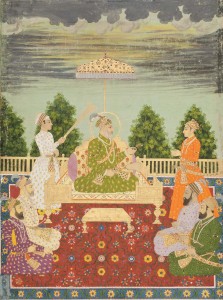
Bahadur Shah I with his sons handing a sarpech to a grandson, ca. 1710. Opaque watercolor and gold on paper. H. 12 3⁄8 × W. 9 1⁄4 in. (31.4 × 23.5 cm). The San Diego Museum of Art, Edwin Binney 3rd Collection, 1990.368.
In this rare iconographic grouping of Bahadur Shah and his descendants, the emperor is shown presenting an exquisite emerald and ruby turban ornament (sarpech) with a tear-drop pearl at its tip to his grandson,who stands with delicately outstretched hands in a full-length orange jama (tunic). The passing of a sarpech usually served as a public gesture of the transmission of authority to a chosen one. In this case, the identity of the young prince remains ambiguous. It is possible that the four sons seated in audience are Jahandar Shah, Azim ush-Shan, Rafi ush-Shan, and Jahan Shah, each of whose sons were to ascend the Mughal throne at various points in the coming decades. Eighteenth-century portraits such as this one, carry significant documentary value since, given the swift nature of political change in this period, they are likely to have been created contemporaneously. Bahadur Shah became emperor at the age of sixty-two; his reign lasted only five years before the question of succession to the Mughal throne was once again thrown open to a host of potential claimants.
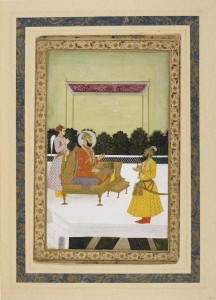
Farrukhsiyar receiving Husain Ali Khan ca. 1715 Opaque watercolor and gold on paper H. 13 5⁄16 × W. 8 1⁄8 in. (33.8 × 20.7 cm) Page: H. 15 5⁄16 × W. 91 3⁄16 in. (38.9 × 25 cm) British Library, J.18,5
The outdoor setting of a garden terrace as a space for courtly transactions occurs very often in the first quarter of the eighteenth century, and is perhaps an indication of the many private, if not surreptitious, political and military alliances that were forged away from the public eye. In India, the gradual dilution of Mughal authority after the death of the Emperor Aurangzeb in 1707, was paralleled by the rise to power of the Sayyid Barha brothers, Abdullah Khan and Husain Ali (pictured here in a bright yellow jama and holding an inscribed paper in his hand), who wielded enormous political clout with the Mughal house. Farrukhsiyar, grandson of Bahadur Shah I, the figure receiving Husain Ali Khan in this painting and distinguished with a nimbus and a fan in his right hand, maintained a strategic alliance with both brothers. He assumed the throne by ousting his uncle Jahandar Shah in 1713 with their help, and ruled for a period of about six years. The softened treatment of the emperor’s features—his arched eyebrow and the upturned eye—are all characteristics of the transitional period of painting during this period when painters such as Bhawani Das were active.
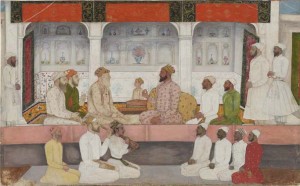
A seated portrait of Sayyid Abdullah Khan holding court. Early 18th century. Gouache on paper H. 8 7⁄16 × W. 13 9⁄16 in. (21.4 × 34.5 cm) The British Museum, 1921,1011,0.4
Abdullah Khan, pictured seated in this image, was the wazir, or prime minister during the reign of Farrukhsiyar. Abdullah Khan and his brother Hussain Ali were the infamous kingmakers of the first quarter of the eighteenth century and the effective administrators of the floundering Mughal Empire. Here, Abdullah Khan, resting on a bolster, one hand raised with the index finger and thumb touching in a gesture of speech (mudra), is engaged in a discussion with an older man who is dressed in a pale printed jama. The heavy over-painting in this scene indicates that the garden pavilion backdrop was a later addition, or was modified significantly to create a decorative effect. The artist has depicted a lower group of figures, which includes a man holding a stringed instrument and another gesturing the spoken word, smaller in size to indicate their lesser status in comparison to the figures above. The scene conveys the air of a private gathering for spiritual and philosophical musings, accompanied with song and music.
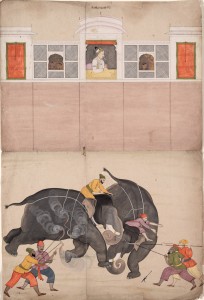
Attributed to Nainsukh (1710–78) Two elephants fighting in a courtyard before Muhammad Shah ca. 1730–40 Ink and color on paper H. 24 9⁄16 × W. 16 1⁄2 in. (62.5 × 42 cm) The Cleveland Museum of Art, John L. Severance Fund, 2005.1.a
The great Pahari painter Nainsukh’s portrayal of the Mughal emperor Muhammad Shah watching an elephant fight is modeled on the folio from the seventeenth-century Padshahnama of Shah Jahan, also on view in this gallery. Muhammad Shah rarely went to war, and the Red Fort seems to have been his administrative and recreational microcosm. He maintained the routine functions of the court—for example, offering morning prayers followed by a visit to the room known as the jharoka-i darshan, from which he surveyed his troops and watched elephant fights. Nainsukh’s picture, given a regional flavor with its muted pastel palette of colors and figures in local dress, underscores the importance of Mughal paintings and subject matter on the painter’s work in the Pahari hill state of Guler. It displays the compositional framework seen in the work of Chitarman, and Muhammad Shah’s profile suggests that the painter was working with a preparatory drawing (Mughal khaka).
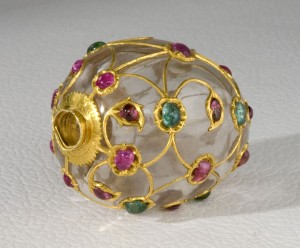
Mango-shaped scent bottle Mid-17th century Rock crystal with rubies and emeralds set in gold H. 1 3⁄4 × W. 2 1⁄4 × D. 1 3⁄4 in. (4.5 × 5.7 × 4.5 cm) Private collection
Carved out of rock crystal with grooves cut on the surface and inlaid with gold and gemstones, this diminutive scent bottle embodies the refined aesthetic of seventeenth-century Mughal India. Likely to have been created during the reign of Shah Jahan, this bottle is an example of the high degree of perfection Mughal artists achieved during this period. It features a network of naturalistic scrollwork of vines in gold wire, with leaves and flowers inset with precious stones and set in high relief to provide the effect of a cage enclosing the crystal. It is missing a stopper, which was probably made of enameled gold.

